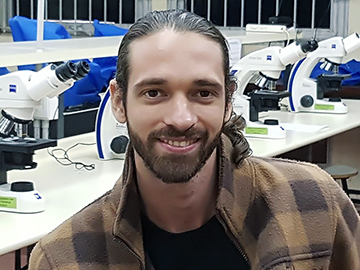Latinamerican PhD fellow from CONICET
Director: Ernesto Ambroggio
E-Mail: lsocas314@gmail.com
PhD Thesis Topic
Interaction of HIV GAG protein with biological membranes models
The human immunodeficiency virus (HIV) is the causative agent of the epidemic of acquired immunodeficiency syndrome (AIDS), a disease that plagues modern society. GAG (Gen-specific antigen) is one of the genes found in the genome of HIV and other retroviruses. The gene produces GAG structural protein. The GAG protein is responsible for coordinating the assembly of the virus at the level of the plasma membrane. Several thousand GAG molecules interact with each other, with RNA and cell membrane to form virus particles which will be released into the extracellular medium. GAG has four domains: matrix (MA), capsid (CA), nucleocapsid (NC) and p6 domain. The interaction of GAGs with the membrane is mainly mediated by its domain MA (matrix) which is myristoylated at the N-terminal and having a rich region responsible basic residues interacting with negative lipids in the plasma membrane, specifically PIP2 lipid. This domain also interacts with the viral RNA. A dynamic association with the plasma membrane GAG is crucial for the formation of viral particles. For this reason, knowing how the physicochemical properties of the membrane (curvature, composition, packaging) modulate the dynamics of its association with GAG is important to understand the interaction of the HIV virus with the cell. It is also important to know how this interaction depends on the presence of RNA and if the diffusional properties of GAG change.



